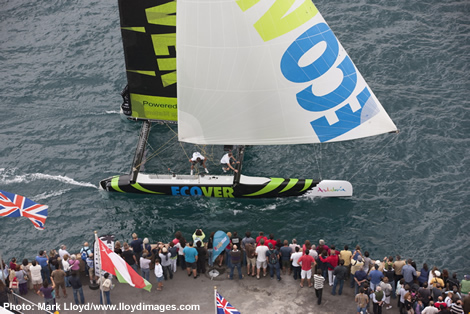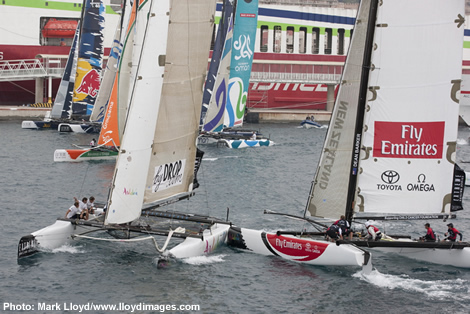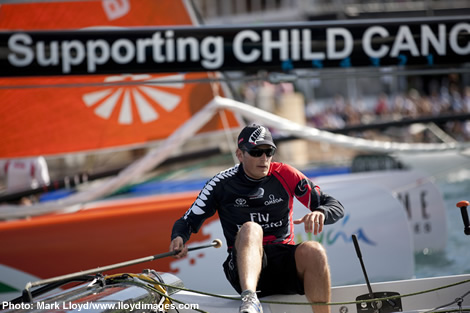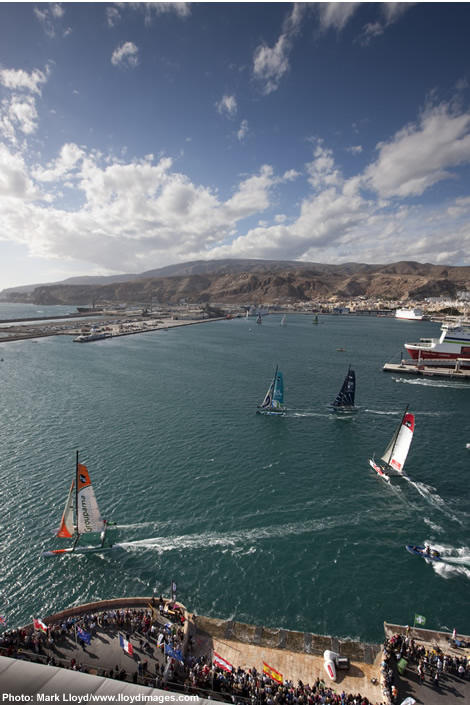
Brave new world
2010 has been a busy year for Mark Turner. On the one hand he will go down in history as the man who turned down the job of running the 34th America’s Cup – a position ably taken up by Iain Murray. Equally Turner’s Cowes-based Offshore Challenge, OC Group, has this year merged with Franco-Swiss company Thirdpole, enabling the new OC Thirdpole to widen their horizons, providing fresh challenge for the Isle of Wight dynamo.
Turner says that the offer to run America’s Cup Race Management happened to come at just the right time and he contemplated it seriously, before making his decision. “It would have been nice to have been focussed on a delivery job for once rather than always having to try and find the funding at the same time. I was genuinely very flattered.”
OC run the Extreme Sailing Series and many of the ideas from that bear striking resemblance to Russell Coutts’ vision for the 34th America’s Cup. Turner is fully in tune with Coutts’ vision. “To promote the sport to a non-sailing audience, there is no question as far as I am concerned. If anyone else questions that, they haven’t got their eyes open. But that is very different to whether that is the right thing for the America’s Cup brand and the competition and the stake holders and the potential teams which are fundamentally private owner-core funded. But that wasn’t relevant to my decision, because I buy into the vision.”
In the end Turner says he decided not to take up the role for personal reasons – he wants to build his life around Lausanne, Chamonix and Geneva, where OC Thirdpole currently is HQed. His wife Anne-Cécile is building a business there too and they have a daughter due to go to school next September. “I didn’t want to uproot and to not even know where to uproot to - it didn’t feel like the right thing.”
Turner admits that in fact he would have preferred a more commercial role within the AC where his expertise lies, the parts in fact that didn’t form part of the ACRM role. Taking the job would also have brought to an end the huge work he has put into OC over the last 12 years. Besides, at the time of the offer he was already well progressed negotiating the merger with Thirdpole. “It is very hard to find the right person to run a small business and for me to be able to evolve my role. I have been trying to do that for some time,” he says.
ThirdPole was set up in 2009 by Rémi Duchemin and Benjamin Chandelier, both previously in business development for Amaury Sport Organisation who’s ‘properties’ include the Tour de France, Paris International Marathon, Alstom French Golf Open, etc. Since setting up ThirdPole has organised or worked on principally endurance sports events such as the Geneva Marathon, the Merrell Oxygen Challenge and the Biathlon World Cup 2011, events which these days are perhaps closer to Turner personally than sailing is.
Turner says he first met Duchemin when he was at ASO. Once ThirdPole was set up, he came on board as a minor shareholder. He also underwrote the 2009 Geneva Marathon for them, so their relationship was already close.
One of the many complexities of the deal was that Turner had to buy out Ellen MacArthur’s shareholding in OC, ThirdPole effectively taking over that shareholding in the newly formed company.
“We fully plan to be one of the leading businesses in the sport of sailing,” says Turner of their objectives going forwards. “We are not lessening anything we are doing in sailing in any way.”
Turner says that while the company’s new base will be in Switzerland, currently in Geneva but probably moving to Lausanne, the Cowes-based arm of their operations will remain. “The commercial side of things will move, because you have to have some things in the same place, but Cowes is a good operational base. For the sailing team side it remains important. Even though we don’t have a big headline project at the moment, that will absolutely remain in Cowes.”
The newly formed company has just announced their first new land-based event. In the ‘Haute Route’, amateur cyclists will negotiate the 14 ‘Alpine Cols’ between Geneva and Nice in a race divided into seven stages, covering 720km, 17,000m of ascent, running over 21-27 August next year.
One of the aspects Turner has found interesting getting involved with events in other disciplines is how they are funded. “A big shift for us is that venues are a bigger part of the equation commercially and I think that will be the case going forwards.” And they are even more crucial for OC ThirdPole’s events outside of sailing. “Mass participation events, outdoor events, it is all about venues and much less about sponsorship today. There is an opportunity there because a lot have often grown quite from a family organisation or a tourism office and very few of them are commercially run. So you have entry fees for example - when there are 5,000 people competing in a bike race is a big factor. And cities generally pay more for them because the economic impacts are direct at that scale.”
With the merger has come economy of scale. For example organising the Extreme Sailing Series host cities, has also provided an opportunity to talk to venues about additional events. “That is interesting and positive for sailing because we can go in with a better and a wider offer, perhaps combining some things,” says Turner. “It won’t happen in 2011, but we would love to develop some of the Extreme Sailing Series events. They are city events, so we are creating stadiums and there is no reason why around the same stadium we shouldn’t have something going on on land and have them completely integrated.”
Extreme Sailing Series
The night before the World Yacht Racing Forum last week, the new look Extreme Sailing Series was presented. For 2011 it will comprise a global tour spanning Europe, Asia and with one event in Boston. The majority of those taking part also represent new teams, even though, as Turner says, the transfer market among existing crew has been rife.
With the iShares sponsorship of the Extreme Sailing Series coming to a close at the end of 2009 and no replacement found, so OC had to fund this year’s circuit themselves to a tune “not far off a seven figure sum,” says Turner. “That was a decision we made at the beginning of the year – to double or quits it.”
However the circuit is now on a firm financial footing as during the merger with ThirdPole, they put the Extreme Sailing Series’s ownership into another company in which Turner holds shares along with other investors. “That allowed us to announce next year without having everything signed,” he says. It has also allowed them for the first time to come up with a five year plan for the close quarters catamaran event.
Among the other shareholders is Ernesto Bertarelli, although Turner can’t tell us about the level of the Alinghi boss’ involvement, however can it be coincidence that they are referring to their events in 2011 as 'Acts'? “He is a key person who could see where it would go. It is a very hands-off relationship as well. OC Thirdpole run this event in the same way as we have always run it. We have found some other people who believe in it and who will let it breathe a bit.”
As a team, Alinghi are competing in 2011, with former Areva Challenge/Groupama tactician Tanguy Cariou as helmsman, however Bertarelli will be sailing at some events. Turner says that Alinghi’s participation and Bertarelli’s investment are entirely unconnected: “As we have often had at OC, we have had teams competing in our own events, but we are good at being fair and haven’t given ourselves an advantage and that is certainly the case here.”
Turner has also been helping the D35 catamaran class, in which Alinghi competes, with their first foray out of Lake Geneva and Switzerland, with two events on the Mediterranean being planned for 2011 after the Bol d’Or Mirabaud.
With the investors on board, so Turner’s commercial team is out in the marketplace attempting to secure backing from two main commercial partners for the Series. However they also intend to get increasing support from the host venues. “We have significantly upped the engagement of the cities, not just the money, but those who want to work with us to make the event bigger.”
With their impressive 2011 venue schedule of Muscat (Oman), China, Istanbul (Turkey), Boston (USA), Cowes (UK), Trapani (Italy), Nice (France), Almeria (Spain) and Singapore, Turner says that some were chosen for ‘strategic reasons’. “We are going to some places where there is no money, but there is a great relationship there to make an event work and we need to capitalise on that. We need to turn the investment we make in 2011 into new partners and better host venue deals again and hopefully attract other brands in at team sponsors. That’s not our income but it is very important for the circuit.”
2011 will see added investment going into the Series that will allow them to scale up events. “We’re doing more on the event next year in order for us to increase the value. We’ll do more on water action and on land action, more classes racing as warm-up acts. Then from 2012 onwards we can ensure that our level of sponsors and venue deals continually evolve upwards financially.”
Aside from the new investors, Turner says that the revenue stream for the Extreme Sailing Series has marked differences to when they first took it on. “iShares represented 90% of our income in the first year. Now our revenues are spread across a lot of different areas.”
So where does he see the Extreme Sailing Series ultimately? “Our place is to be the most attractive sailing event from a commercial perspective, a place where brands and host venues come to when they want to get into the sport because we are really tight, with six figure sum budgets and it is a great stepping stone into the sport.”
For 2010 Turner says participation cost top teams 450,000 Euros all up, assuming 100,000 Euros for the boat amortised over three years or chartered. For 2011 with the enlarged circuit, team budgets will be closer to 650,000 Euros, good value for a series that in one year visits the US, Europe, the Middle East and Asia.
“It needs to work for sponsors - not just today’s but next year’s. We need better quality consumer brands and we need to maintain the good B2B brands. The only way we will really evolve that is to take the event up another level on the media side and public side and the venue side and that is a long process. We are at the beginning of a new five year plan after these first four years establishing the event very firmly sporting wise, venue-wise, etc.
“Our vision of is to be the best sailing event by 2014 - not the biggest, nor the one with the most money, but the best when measured from outside of the sailing world. If you are a brand or a venue looking at the sport of sailing and going into sailing, we want to be the commercially soundest product and to be viewed in that way. But,” Turner emphasises “it also must be good from a sailing perspective. We have got to have the best sailors wanting to be there – that is a constant in every decision we are making.”
He maintains an increasing number of sailors ‘get’ the stadium-style format of racing and the ever adaptable race courses. “It is just as competitive, just as hard to win and just as fair to win but having more commercial objectives mixed in, to entertain people with the sport.”
But in addition to their events being competitive it is crucial they also be entertaining and finding the balance remains key. As Turner puts it: “If we don’t make professional [ie commercial] sailing entertaining then it will not survive – no question. If we went too far and lost the sporting credibility that would be a big mistake. Finding that equilibrium is difficult, but I don’t feel that is a challenge now. Stadium sailing has credibility, but it is just different. We don’t have a 20 minute beat. Interestingly this year we committed to all the teams, before the public village opened, to do longer and more conventional races, but the almost unanimous feedback was that 20 minutes was just great. After 20 minutes, the third lap or fourth lapm there aren’t any changes.” For example at this season’s last event in Almeria, some of these longer race started outside of the harbour, but finished inside, something that was subsequently emulated in Valencia at the TP52 World Championship.
“I think generally there is a shift. If you talk to sailors, more professional sailors are saying this stadium format is where it is at, so it has got clear credibility from a sporting point of view, but it is different. It is about manoeuvres and fast thinking. It is about hearing the public cheer you when you go around a mark and that is a very nice thing for a sports person – being appreciated by fans. There is a shift and the smart people are realising that if they buy into that and are ready to share a bit more about what they are doing there will be more rewards to them and their careers will have more options.”
Certainly for 2011 an interesting selection of teams are signing up for it. Among the line-up are Cup teams, Artemis Racing and Emirates Team New Zealand. A surprise entry was that of Patrizio Bertelli’s Luna Rossa with 2010 Extreme Sailing Series winning helmsman Paul Campbell-James, while Alinghi are returning having previously won in 2008 with Ed Baird as skipper.
“Eight great teams is our benchmark,” says Turner. “but there will be more than 10 teams at most of the events because there’ll be a home team city boat we’ll be running and there are a couple of other campaigns out there that might make it as well.” Turner says that he doesn’t regard fleet size as a measure of success, as more than this will create not just docking problems but too many boats on the confined race course. “We have 10 very quality teams, a diverse mix of sailors, people from ocean racing, the Cup, Olympics, match racing guys – which is great.”
We round off this article tomorrow, when Mark Turner talks about his other clients such as the Multi One Design and Artemis and shares his observations about the sponsorship market.
Read part two here














Latest Comments
Add a comment - Members log in